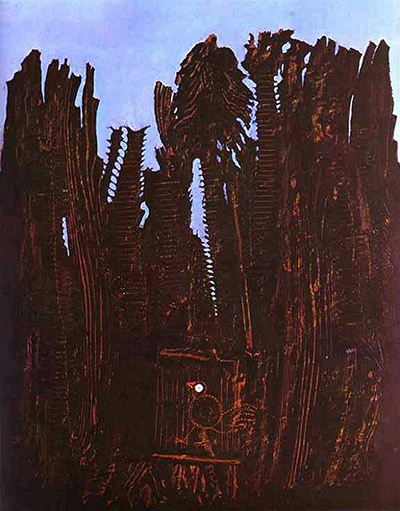Forest and Dove arrived in 1927 and is one of Max Ernst's most darkly-lit paintings. It is now owned by the Tate Gallery in London, having been bequethed from a private collection.
The darkness is applied for the purpose of this nocturnal setting, where abstract forms of trees are spread across the canvas to create a dense forest. The dove mentioned in the title sits in the centre, close to the bottom of the painting. It is made obvious by its bright eye, but otherwise makes use of the same colour scheme as the environment in which it is perched. The first challenge with any Max Ernst surrealist painting is to identify the various elements of his composition, and then to decide upon the symbolic values and inspirations behind each one. Doves, for example, have been used for symbolic value by countless numbers of artists across a variety of movements, but why was it used here?
It is believed that there was a forest close to the artist's childhood home and that he felt a great sense of intrigue and fear towards it during his early years. That would explain the dark, nocturnal setting. The extension to this theory is that Ernst himself is the dove in the near side of the picture. The bird is positioned intentially to give the impression of being trapped. Indeed, forests have been used by German artists in other movements to serve as a symbol of imagination and may have been done so here by Max Ernst as well. Typical of his career, we are left trying to decipher the meanings without any concrete evidence, such as notes left by the artist (perhaps some quotes have been left in German or French, but have yet to be translated into English).
This painting measures precisely one metre tall, and 82cm wide. There were several painting innovations created by Max Ernst and one of them is showed here. Grattage involved paint being scraped around which had the impact of revealing lower layers of oil. It is used here across the trees but it is hard to appreciate the effect without seeing the painting in person, which is possible for those in London as it is normally on display at the Tate Modern. For the images featured here, you can just about make out the lines in lighter tones across the brown trees, which presumably indicates the colours of paint used below the darker tones. He makes a series of equally spaced horizontal lines on some of the narrower shapes, and then more of a mixture elsewhere. In one case he uses the technique to produce the dove who sits centrally within the piece, nearer the bottom of the canvas.
This painting can be found in the collection of the Tate in the UK, which runs multiple galleries across the country, including Tate Modern and Tate Britain. They acquired this piece in 1962 and it is normally out on display as a part of their permanent collection, thanks to the prominent reputation of Max Ernst. They actually host an exceptional selection of modern art within the Tate Modern building which has actually recently been extended in order to allow more of their collection to be displayed at any one time, as well as adding other services such as greater catering and commercial opportunities. This venue is currently one of the most visited art galleries in the world, partly due to the famous names found on display here. The other galleries under the Tate banner allow it to display the other elements of its collection, some of which came well before the modern art period.
Visitors to the Tate Modern will also be able to see some of Claude Monet's Water Lilies series, as well as Bathers at Moritzburg by Ernst Ludwig Kirchner, A Young Lady's Adventure by Paul Klee as well as a number of pieces by Pablo Picasso and also Robert Delaunay. These are just a few of the exciting masterpieces to be found in this venue, with many more to interest you within their permanent collection. There are also regular exhibitions of major artists where a number of their works are loaned in from elsewhere for a few months, allowing rare opportunities to see a large selection from their career under the same roof. The Tate itself hold a much more diverse selection of work than this, with more traditional art displayed elsewhere, with several more locations in London available, as well as some newer ones elsewhere across the UK.




